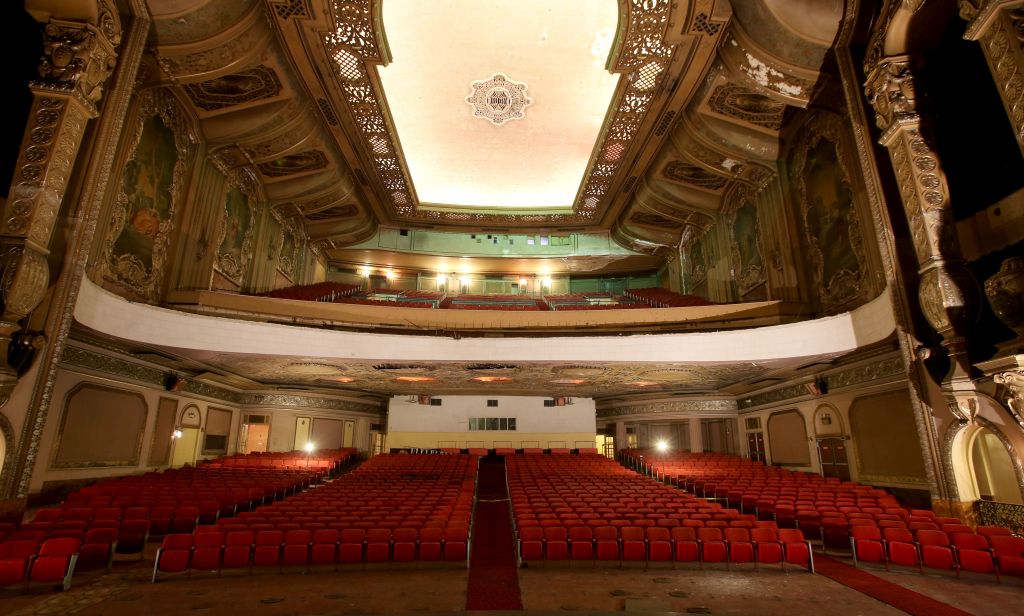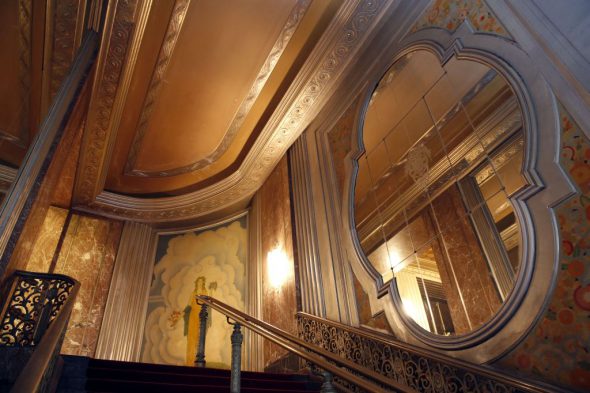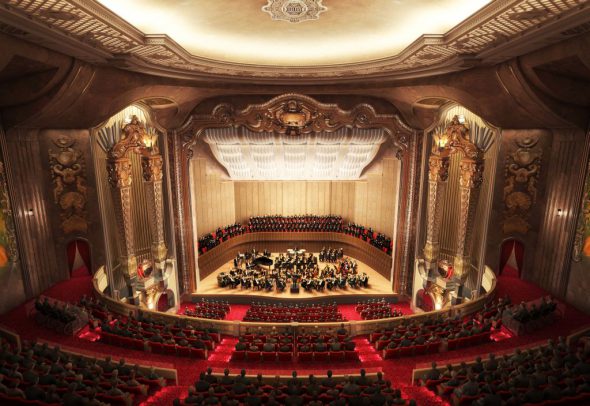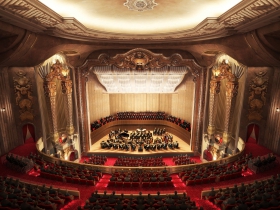Marcus Performing Arts Seats Better in Orchestra or Center Lodge
Get a daily rundown of the top stories on Urban Milwaukee

Center stage looking back. Photograph by Jonathan Kirn.
It sounded like a revolution for Milwaukee's performing arts scene. In 1 week we were met with news that both the Milwaukee Symphony Orchestra and Milwaukee Ballet were poised to build their ain functioning space, pregnant the Marcus Middle for the Performing Arts would lose two of its main tenants.
Equally it turns out, the Ballet story, reported by OnMilwaukee.com, is quite misleading. Two sources close to the situation told me the ballet will non be leaving the Marcus Heart and Anne Metcalfe, a spokesperson for the ballet, says "I can confirm that Milwaukee Ballet is not intending to build its own operation space." But they might be looking to move their offices and ballet studio, now located at 504 W. National Ave., to a Third Ward location. Metcalfe would say simply that "To best fulfill our mission, a possible new dwelling house for the Ballet has long been a consideration. We keep to explore options."
As for the orchestra, at that place have been discussions of the MSO finding its own space for more than than 30 years, which made me wonder about its $120 one thousand thousand proposal to renovate the quondam Warner movie theater at 212 West. Wisconsin Ave. into a symphonic hall. But I'g now convinced the project could and should happen and that it volition be hugely beneficial for both the symphony and for Milwaukee's downtown. This could plug the last major hole in Downtown, helping usher in a resurgence of Due west. Wisconsin Ave. and the Yard Artery Mall.
MSO president Mark Niehaus says the project has a "triple bottom line" impact: (1) helping the symphony control its destiny and hike its earned revenue, (2) saving and preserving a gorgeous celebrated edifice ("We're probably the only tenant big enough to do this," he says) and (3) sparking a renaissance on Wisconsin Ave.

Stairway in the Grand Warner Theater. Photo past Jonathan Kirn.
There's really a quaternary bottom line, though information technology's an artistic one: the sometime cinema has far better acoustics than the Marcus Centre's Uihlein Hall, where the symphony has performed for almost five decades. Dorsum in the early 1980s I wrote a cavalcade for Milwaukee Magazine about the hall's acoustics, with musicians offering countless criticisms. It only wasn't a adept hall acoustically and vicious short both in delivering a full, balanced sound for audiences and allowing musicians to hear each other.
Former music directors like Lukas Foss complained nigh the acoustics while his successor Zdenek Macal tended to push for a louder audio to make up for the problem. This was pointed to as a reason the MSO was panned in a 1989 performance at New York's Carnegie Hall, with the New York Times' Bernard Holland infamously declaring "the Milwaukee Symphony is not a very adept orchestra." (Even and then this was a rare critical pan.)
In the 1990s improvements were made in the hall, including the addition of a arrangement to electronically enhance the reverberation, which helped, but didn't eliminate the basic problem of the hall's configuration. Uihlein "is almost every bit wide as it is deep, whereas the Warner theater is more than of a shoebox," Niehaus notes — meaning longer than it is deep, like near of the great symphonic halls. "Uihlein is much ameliorate for theater and opera and ballet."
Every bit far back every bit 2001, the symphony did an acoustical exam at the Warner, Niehaus notes. The Marcus Corporation, which owns the theater, spent considerable coin to eliminate its old partitioning into a duplex theater, simply so the sound of the entire hall could exist tested. A plywood stage was built and the orchestra tried out the hall for an entire day. "It was an unqualified success," Niehaus recalls.
Niehaus was then the symphony's principal trumpet player and he was struck by the Warner'southward wonderful, "naturally reverberant" acoustics. In 2012, Niehaus was hired every bit MSO president, and it may non exist entirely a coincidence that the showtime viable endeavor to create a new hall has been overseen past a former musician. (Though Niehaus says information technology's all driven by business reasons.)
The reality that presidents earlier Niehaus faced is besides much resistance from the philanthropic community to such a project. Historically, civic leaders take since the 1980s shot down the idea of spending on a new symphonic hall, because the donor community created the Performing Arts Heart in 1969 (and later renamed the Marcus Center) as a home for groups like the MSO, Florentine Opera, Milwaukee Ballet and Milwaukee Rep. (Of class the Rep was able to go civic support to leave the PAC's Todd Wehr Theater and create its own circuitous of theaters in the 1980s.)
The symphony was left performing in a hall where it couldn't get the prime holiday dates, because the ballet had information technology locked up for the Nutcracker. Merely the situation got worse after the Marcus Center, under pressure to lower its almanac subsidy from Milwaukee County officials, began booking touring Broadway shows in the mid-1990s.
As a result, Niehaus notes, only 23 to 25 of its 40 weeks of performances are held at Uihlein, with venues like the Pabst, Riverside, St. Josaphat Basilica and others filling the gaps. Worse, the dates it can go for Uihlein are oft the less desirable ones. Even worse, the MSO typically has to await till the dates for the Broadway shows are filled before they can blast downward invitee musicians and conductors.
All of these constraints significantly reduce the earned income potential of the symphony. With its own hall, the MSO could skip bad times similar Easter Calendar week, and maximize boom times similar the Christmas and New year'south season, while avoiding concerts in smaller venues like churches and being better able to compete with other orchestras internationally to blast down top performers and conductors. The MSO could also gain further revenue by renting out the hall for the 12 weeks it'due south not in use. And with Gary Witt's empire of the Pabst, Riverside and Turner Hall about at chapters, the refurbished Warner would give him another unique architectural precious stone to sell to touring acts.

Rendering of renovated Chiliad Warner Theatre.
The project as envisioned would purchase and develop the neighboring 2-story building at 200-208 W. Wisconsin Ave. It would be connected to the new concert hall through an adjoining wall and converted into an expanded antechamber, which could include a bar expanse, box office, glaze check and restrooms. And all the revenue from the bar and other acquirement makers would get to the symphony. The theater edifice has 12 floors and Niehaus may reserve its elevation two floors for a penthouse-level minor performance space that could bring in more audiences and acquirement.
The theater building's basement could provide dressing rooms for musicians and small warm-up spaces. The MSO would also relieve money spent trucking instruments in and out of Uihlein; they would simply stay at the symphony'due south new abode.
Niehaus says the MSO has raised half of the $120 million needed, which would include $20 million in endowment money. Much of it is pledges contingent on the project happening but some of information technology is cash given as venture capital to become the projection rolling. Every bit for the problem the Milwaukee Art Museum faced, when its Calatrava project ran over upkeep and ate upwardly the endowment coin intended to spin off annual operating support, Niehaus says "nosotros will take a guaranteed maximum price negotiated with a contractor earlier a shovel hits the ground."
Music lover Myron Heaton, who created the Grand Warner Theatre Trust to save the historic theater and whose organization has now substantially been folded within the MSO effort, say Niehaus has faced a divided donor customs, with "some not wanting to go out Uihlein, some wanting to build a new hall, and some favoring a move to the Warner."
Yard Warner Theatre (2013)
But Niehaus exudes confidence nearly raising the money, and selling the project. For older suburban MSO fans, a location on Wisconsin Ave. may exist daunting, merely he notes the H2o Street was hardly a prime location when the PAC opened in 1969.
And the reality is that Downtown's west side is nearly to explode, with the Bucks loonshit and Alive Block soon to open, with some 700 residential units beingness developed on or near Wisconsin Ave., with aggressive new local owners redeveloping the G Avenue mall, with a glitzy new hotel project likely to fill the empty block on 4th and Wisconsin, and with Marquette University expanding every bit far east as 7th street. Symphony goers will be able to park in the One thousand Avenue'due south huge parking lot, which gets most of its current customers during the solar day; the mall's co-owner Tony Janowiec is thrilled about the MSO plan and is nationally known for creating a pleasant, convenient feel in his parking lots.
The MSO project, in short, may exist the final thing needed to complete the downtown puzzle. As Niehaus told the Journal Sentinel, "This is kind of the last spot in Downtown that needs this kind of spark and nosotros're happy to exist that."
As for the bear on on the Marcus Center, it will lose at least 23 weeks of rental income, only I'm told it amounts to well less than a 10th of its $11.3 million annual budget. Marcus Center President Paul Mathews was out of town and unavailable for annotate, but County Executive Chris Abele expressed confidence the Marcus Center would do fine.
"There are some scalable costs [to reduce expenses] and I wouldn't underestimate the Marcus team's ability to fill up upwardly more dates," he says. "If I were on the Marcus Eye'south board I would be talking non about the loss but where the opportunities lie."
Every bit for the symphony's relocation, Abele, a former MSO board member, hailed it as a home run. "Uihlein Hall was non actually designed for a symphony," he notes. "The Warner edifice is architecturally distinctive, information technology's correct downtown, and it's going to have an increasing density and activeness around it. The is every bit optimum a time for the symphony to motility as there always will be."
Inside the Grand Warner Theatre (2016)
Rendering

If you think stories like this are important, go a fellow member of Urban Milwaukee and aid support real, independent journalism. Plus you get some absurd added benefits, all detailed hither.
More about the Bradley Symphony Eye
- Friday Photos: Flood Delays Opening of Bradley Symphony Heart - Jeramey Jannene - Sep 11th, 2020
- Plats and Parcels: Symphony Hangs New Sign - Jeramey Jannene - May 10th, 2020
- Eyes on Milwaukee: Symphony Center To Get New Sign This Weekend - Jeramey Jannene - May 6th, 2020
- Friday Photos: Within the Bradley Symphony Heart - Jeramey Jannene - Feb 14th, 2020
- Friday Photos: Symphony'southward New Abode Takes Shape - Jeramey Jannene - Jan 17th, 2020
- Eyes on Milwaukee: Symphony Moves a 625-Ton Wall - Jeramey Jannene - Aug 13th, 2019
- Friday Photos: Full Speed Ahead on Symphony Project - Jeramey Jannene - Sep 7th, 2018
- Eyes on Milwaukee: Symphony Breaks Ground on New Hall - Jeramey Jannene - Jun 21st, 2018
- Eyes on Milwaukee: Symphony'due south Grand Theatre Programme Moves Forward - Jeramey Jannene - May 8th, 2018
- Eyes on Milwaukee: Committee Okays Symphony Program for G Theatre - Jeramey Jannene - May 1st, 2018
Read more well-nigh Bradley Symphony Centre hither
Source: https://urbanmilwaukee.com/2016/12/20/murphys-law-symphony-move-huge-for-downtown/
0 Response to "Marcus Performing Arts Seats Better in Orchestra or Center Lodge"
Post a Comment